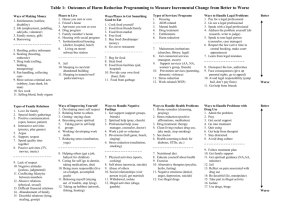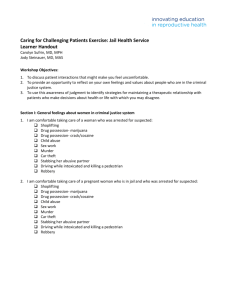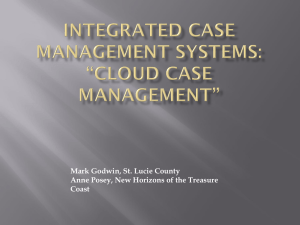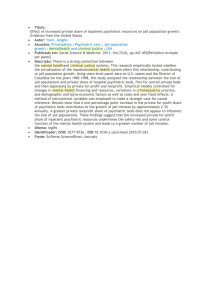National Best Practices - Michigan Council on Crime and Delinquency
advertisement
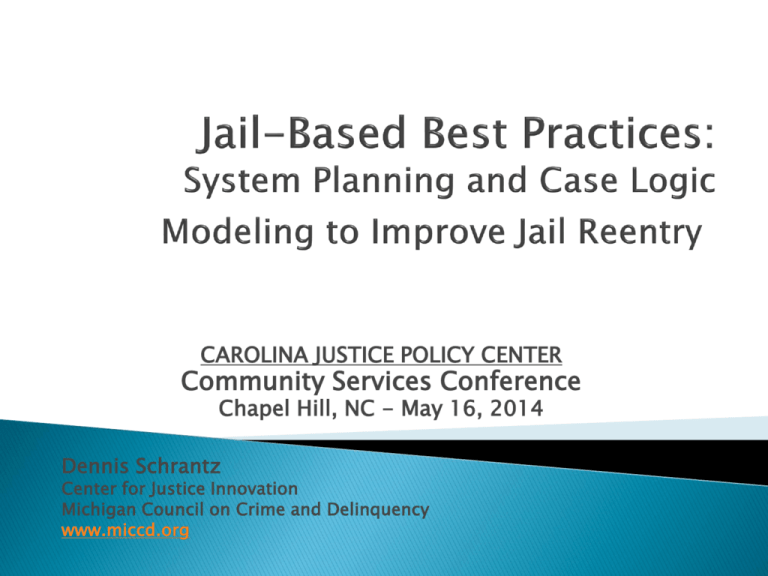
CAROLINA JUSTICE POLICY CENTER Community Services Conference Chapel Hill, NC - May 16, 2014 Dennis Schrantz Center for Justice Innovation Michigan Council on Crime and Delinquency www.miccd.org Jail systems in the U.S. are crowded at both the pre-trial and posttrial stages of the justice process. Crowding in jails affects sentencing decisions. Judges – who are cognizant of local conditions – may sentence more defendants to prison due to local crowding. As a result, crowding is often more pronounced at the pre-trial stage. Release-and-detention decisions made by judges carry enormous consequences for both the community and defendants. But less than 10% of judicial officers across the country use pretrial risk assessment tools to make these decisions showing a disregard for evidence based practices – which begin with validated risk and need assessment The Arnold Foundation, The Hidden Costs of Pretrial Detention, Lowenkamp, et al, Nov, 2013 And yet….. a recent study (Lowenkamp, 2013) found that: Longer pretrial detentions, up to a certain point, are associated with the likelihood of Failure to Appear pending trial, particularly for low risk defendants. Longer pretrial detentions are associated with the likelihood of new criminal activity pending trial, particularly true for defendants deemed to be low risk. The longer low-risk defendants are detained, the more likely they are to have new criminal activity pending trial. Being detained pretrial for two days or more is related to the likelihood of post-disposition recidivism. .. as the length of time in pretrial detention increases, so does the likelihood of recidivism at both the 12-month and 24-month points. The Arnold Foundation, Assessing Pretrial Risk without a Defendant Interview; Lowenkamp, et al, Nov, 2013 Sheriffs and jail administrators are in a unique position to lead the charge on the use of evidence-based and best practices in their communities by virtue of their professionalism and standing in the system. Particularly when considering improved jail reentry, best practices begin with designing a systems approach or “blueprint” that expresses how the jail wants to operate within the context of state and local justice system performance expectations and goals. Internal systems planning requires managers to specify the logic of their effort. When the logical connections among outcomes, practices, the rationale, and assessment of stakeholders are specified, systems can improve programmatic capabilities, reduce costs and increase performance. A Blueprint creates…” a common architecture for understanding and improving system processes… to optimize the flow of work and information …to facilitate the most efficient and appropriate use of resources…explore a variety of evidence-based improvements and build an infrastructure to monitor results. Northpointe, Inc. , Copyright 2011 – Used with Permission The Five Principle Functions of a Jail Blueprint HANDOUT Workload Demand: This defines the demands on the system based on state and local policy (and politics), economic conditions, community and demographic factors that shape the size and the characteristics of the jail population. What is expected of the jail in terms of responding to these demands? Strategic Direction: This is the way that jails expect to do business, stressing the values of the leadership and staff and the evidence based principles they will follow. The strategic direction communicates internally and externally what the people who run the jail believe in. These values and principles communicate to state and community partners a level of confidence that the jail can be/is effective and can produce the best results possible (e.g. better manage jail beds, reduce the need for jail beds, reduce recidivism, and help prevent future crime)? The Five Principle Functions of a Jail Blueprint (cont’d) Case Management Logic: Describes the work that will be done to produce the desired outcomes as a direct result of the values and principles driving jail operations and the supervision of inmates post-release – which is occurring more frequently due to “workload demands” (for example, AB109 in CA, jail crowding and emergency releases to supervision in urban jails). The case management logic communicates how those values and principles will dictate jail operations at a case level – and in some jurisdictions, after the stay in jail moves into community supervision. The value of the case management approach increases as the alignment with evidence-based principles improves. The blueprint helps focus expectations on effectiveness and ways that performance will be measured. Effective assessment and case planning technologies will ensure that the information required to implement the case management logic is in place. The Five Principle Functions of a Jail Blueprint (cont’d) Performance Outcomes: Captures the definitions of what the jail leadership and staff and the community expect to achieve, particularly when new initiatives are put into place. Process measures should be detailed; for example, risk and need assessments being conducted, case plans being driven by those assessments, etc. Impact measures should be detailed relating, of course, to crime reduction and improved system outcomes. Again, effective assessment and case planning technologies will ensure that the information required to monitor and report on performance are in place. The Five Principle Functions of a Jail Blueprint (cont’d) Infrastructure: Infrastructure includes a range of capacities including technology, funding, policy formation, staffing and training, buildings, equipment, communication and coordination mechanisms and management activities. This is the place to determine what is needed compared to what is in place through a “assets, barriers, gaps” assessment which can help drive Clearly inventorying existing and needed infrastructure is especially important because infrastructure for supporting effective services are usually extensive, undervalued by the public, difficult to maintain, constantly changing, and routinely cut across numerous agency boundaries in the human services and justice system. They are fundamental and will need to be more fully addressed depending on Workload Demands and Performance Expectations Mapping the case-flow process (the jail case logic model) is a way for systems to align decisions beginning in the jail and continuing in the community as a jail reentry process. The justice and human service systems are characterized by a common series of decision points that form a literal “playing field” upon which the efforts of a variety of local partners play out to produce outcomes. As a result, the agencies that make up the system must work to specify the design and quality of the decisions within their responsibility. These agencies are responsible for assuring the flow of information into and out of their decision processes. These efforts help assure the alignment required to demonstrate system performance and outcomes. A FIVE STEP PROCESS HANDOUT 1. Assess Risk (Jail Intake): Assess offender risk level and target offenders who pose the highest risk for re-offending 2. Assess Need and Responsivity: Administer assessment battery to identify the offender’s criminogenic needs and dynamic risk factors (full COMPAS). 3. Develop Behavior Management Plan: Utilize risk, need, and responsivity assessment results to inform the development of an individualized case plan guiding the types and levels of services required to address needs. 4. Deliver Programs: Deliver Cognitive-Behavioral Based Programs offering varying levels of dosage (duration and intensity). 5. Measure Progress: Conduct periodic case reviews to evaluate progress, update treatment plans, measure treatment gains, and determine appropriateness for program completion. With the jail reentry case flow process specified, there is an opportunity to explore how the community-based case management process occurs. The Case Management Logic Model provides a framework for linking casework with performance, a critical linkage in establishing the effectiveness of the approach. The Case Management Logic includes assessment, interpretation, case planning, execution and evaluation. Specifying these fundamental stages of case management helps to standardize and communicate the approach while providing an objective reflection of the strengths and weaknesses of the process. A FIVE STEP PROCESS 1. Review Assessed Risk: Review risk and need assessment to determine supervision recommendation and review reentry case plan 2. Finalize Case Supervision -Behavior Management Plan: ◦ ◦ ◦ ◦ ◦ Assign Supervision Level Finalize Plan (specific tasks, activities and responsibilities) Identify Incentives Establish Restrictions and Expectations Refer for Treatment and Other Services to Address Needs, Goals and Tasks in Plan 3. Monitor Progress with Conditions and Plan: ◦ ◦ ◦ ◦ ◦ Monitor Conduct and Conditions Compliance Reward Compliance and Progress Respond to Non-Compliance Evaluate & Revise Plan & Conditions Update Goals, Set New Expectations, Identify New Incentives 4. Discharge from Supervision 5. Outcomes: ◦ Minimize Criminal Activity During Period of Parole ◦ Minimize Technical Violations, Revocations ◦ Reduce Rates of Recidivism

